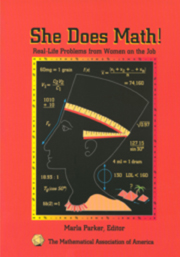Book contents
- Frontmatter
- Preface
- Contents
- Problems by Subject
- Environmental Psychology
- Software Engineering; Computer Science
- Archaeology
- Mathematics and Computer Science
- Civil Engineering
- Mathematics
- Electrical Engineering
- Physics; X-ray Astronomy Research
- Mathematics
- Physics; Astronaut Crew Training Instructor
- Business Data Processing
- Software Engineering; Real Estate Investment
- Quality Engineering
- Health Science
- Nursing Education
- Electrical Engineering; Space Systems
- Oil and Gas Accounting
- Business Administration Higher Education
- Aerospace Engineering
- Structural Engineering
- Computer Science
- Mathematics
- Dietetics—Foodservice Management and Nutrition
- Electrical Engineering
- Chemical Engineering, retired
- Software Engineering
- Immunology and Microbiology
- Mechanical Engineering
- HMO Pharmacy Practice and Management
- Ophthalmology
- Electrical Engineering
- Fish Pathology
- Computer Science and Computer Graphics
- Mathematics and Computing
- Electrical Engineering
- Astronomy
- Author
- Mathematics
- Reflections on WAM
- Solutions
Software Engineering
- Frontmatter
- Preface
- Contents
- Problems by Subject
- Environmental Psychology
- Software Engineering; Computer Science
- Archaeology
- Mathematics and Computer Science
- Civil Engineering
- Mathematics
- Electrical Engineering
- Physics; X-ray Astronomy Research
- Mathematics
- Physics; Astronaut Crew Training Instructor
- Business Data Processing
- Software Engineering; Real Estate Investment
- Quality Engineering
- Health Science
- Nursing Education
- Electrical Engineering; Space Systems
- Oil and Gas Accounting
- Business Administration Higher Education
- Aerospace Engineering
- Structural Engineering
- Computer Science
- Mathematics
- Dietetics—Foodservice Management and Nutrition
- Electrical Engineering
- Chemical Engineering, retired
- Software Engineering
- Immunology and Microbiology
- Mechanical Engineering
- HMO Pharmacy Practice and Management
- Ophthalmology
- Electrical Engineering
- Fish Pathology
- Computer Science and Computer Graphics
- Mathematics and Computing
- Electrical Engineering
- Astronomy
- Author
- Mathematics
- Reflections on WAM
- Solutions
Summary
In high school I took the only introductory computer courses that were offered, because my older brother had taken them years earlier. He would bring home pictures that he had generated with the computer and allowed me to color them. So I decided that when I got to high school, I would take computer courses so I could create pictures on the computer, too. Although I wasn't very interested in coloring pictures by the time I got to high school, I did take computer courses, and discovered that my brain seemed to work well in the logical world required by computers.
In college, I made computer science my major, and received a BS/CS from SUNY/Buffalo in 1986, and a MS/CS from SUNY/Buffalo in 1987. But at first, I discovered that I didn't know the first thing about computer science, and there were so many subfields that I didn't know what I wanted to do. After taking courses in graphics, compilers, vision, operating systems, and artificial intelligence, I found two areas interesting. The first was artificial intelligence, a hot field at that time. It seemed really futuristic to program computers that could mimic humans, and I did my master's work in that area.
At the same time, I discovered the world of operating systems, and UNIX in particular. I had to use a new UNIX machine for some of my coursework, and I quickly discovered the wonderful social aspects of the system, particularly the “talk” and “write” programs.
- Type
- Chapter
- Information
- She Does Math!Real-Life Problems from Women on the Job, pp. 108 - 110Publisher: Mathematical Association of AmericaPrint publication year: 1995

